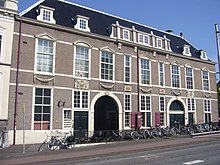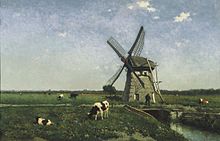Koninklijke Academie van Beeldende Kunsten
The Koninklijke Academie van Beeldende Kunsten (abbreviation: KABK ; German Royal Academy of Fine Arts ) in The Hague is the oldest art academy in the Netherlands and one of the oldest in the world. It is the training place of a number of important artists of the Hague School as part of the art movement of Dutch Impressionism and was at the same time in the direct environment of the 2nd Golden Age of Dutch painting. However, for a long time in the 19th century, training was still strongly oriented towards the classical curriculum at the beginning of the 19th century, before the modern age had opened up.
history
A guild of St. Luke in The Hague has come down to us as early as the 16th century . In 1656 the Confrérie Pictura split off from this , which had set itself the goal of organizing professional painters separately from the so-called kladschilders (blots, brushes). On September 29, 1682 the members of the Confrérie Pictura - Willem Doudijns, Theodorus van der Schuer, Daniël Mijtens, Robert Duval and Augustinus Terwesten - founded an academy to offer the guild members the possibility of further training in drawing and painting. It was the direct forerunner of the later Royal Academy of Fine Arts.
building
The end of the 18th century was marked by a period of decline and economic and political crisis, and difficult times began for the academy with the loss of financial support. The low point was around 1800 when it had only ten students. From 1821 it was given more importance again when the School voor Burgerlijke Bouwkunde was attached to it. After the academy had previously been located on the Korenbeurs ( grain exchange ) and later the Boterwaag (weighing house for butter), it was able to move into its own house on the Prinsessegracht in 1839 , a neoclassical building created by Zeger Reyers .
With the disappearance of the guilds in the 19th century, architectural drawing and technical drawing became increasingly important. In this context, the academy also played an important role. In addition to building studies, the course of the century also saw the imparting of floor plan planning and design studies for members of the craft sector. During this period the academy had more students in the technical branch than in the art academy. In addition, the academy began to train teachers again, which until a few decades ago had been its most important branch.
Hague School and Modern Times
At the end of the 19th century, the Hague art scene flourished, known as the Hague School . got known. Many followers, such as Breitner , the Maris brothers ( Jacob Maris and Matthijs Maris ) and Bosboom , were trained in the academy.
In the first half of the 20th century, the academy played a pioneering role in the Netherlands. Under the influence of the Bauhaus , the new departments of graphic design, advertising, photography, design and furniture design were created. Lecturers of the avant-garde at that time were Gerrit Kiljan (1881–1961), Paul Schuitema (1897–1973), Paul Citroen (1896–1983) and Cor Alons (1892–1967). The academy was also one of the first Dutch schools to expand its curriculum by teaching industrial design .
In 1938 a new building designed by the architects Plantenga, Buijs & Lürsen was erected on the site of the old house , which underwent a general renovation in 2000 and was expanded to include a building by the architect Van Mourik Vermeulen . In 1990 the academy merged with the Royal Conservatory to form the Hogeschool van Beeldende Kunsten, Muziek en Dans (University of Fine Arts, Music and Dance). At the same time, a more intensive cooperation with the newly established art faculty at the University of Leiden has started - in the Netherlands the first formalized cooperation between a university and an art school is taking place, which allows students to do so within a semester at both the University of Leiden and also heard from the Royal Academy. The range of teaching new technologies and new media has been expanded.
The academy organizes the biennial Gerrit Noordzijprijs for the design of fonts and character sets .
Well-known graduates of the 19th and 20th centuries
Selected sources
- Beljon, JJ (1982): 300 jaar Koninklijke Academie van Beeldende Kunsten 's-Gravenhage 1682–1982: Een begnopt overzicht . 's-Gravenhage ISBN 90-6402-006-X (Dutch).
- Sillevis, John; Kraan, Hans and Dorn, Roland: The Hague School - masterpieces of Dutch painting of the 19th century from Haags Gemeentemuseum. Exhibition catalog, Ed. Braus, Heidelberg, 1987, ISBN 3-925835-08-3 .
- De Leeuw, Ronald; Sillevis, John and Dumas, Charles (Eds.): The Hague school - Dutch masters of the 19th century . Exhibition catalog, Gemeentemuseum, The Hague, Weidenfeld & Nicolson, London 1983. ISBN 978-0-297-78219-3 (English).
- Wagner, Anna: The Hague School - Dutch painters a hundred years ago. Rheinisches Landesmuseum Bonn 1972. ISBN 3-7927-0142-1 .
- Reinink, Adriaan Wessel: KPC de Barzel - Architect , Uitgeverij, Rotterdam 1993, ISBN 90-6450-161-0 (Dutch).
Web links
- Official website (Dutch, English)
Individual evidence
- ↑ These art guilds were part of the 1st Golden Age of Dutch painting. Almost every Dutch city had one of its own.
- ↑ This development must be seen before the well-known I. Golden Age of Dutch painting.
- ↑ That was due to the difficult economic times at the time. Also triggered by England's continental blockade.
- ↑ The former grain exchange now houses a cultural center for the city of The Hague.
- ↑ These skills for the planning and construction drawings of buildings became important due to the building boom and the growing demands.
- ↑ This is about the international movement of impressionism . The Hague School was an important part of Dutch Impressionism and part of the 2nd Golden Age of Dutch painting .
- ↑ George Hendrik Breitner was a co-founder of the Amsterdam Impressionism movement .







